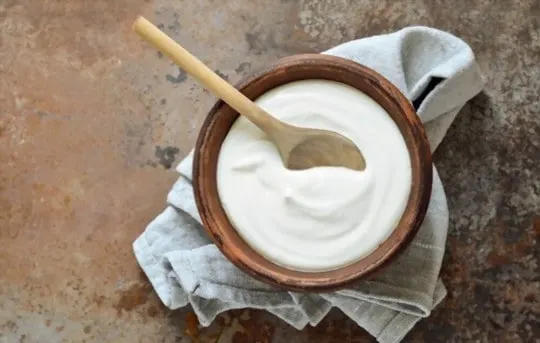Yogurt has been a staple of Indian cooking for thousands of years. Yogurt is the generic name for a cultured milk product.
The word is derived from the Turkish word Yoğurt, which means “thick”.
Over the years, yogurt is available in various flavors (plain, vanilla, strawberry, chocolate), and it is hugely popular to add in desserts and baked goods.
There are also different types of yogurt-like Greek Yogurt, which is thicker than US-style regular yogurt.
However, the problem with plain and flavored yogurts is that they have a liquid texture.
If you add yogurt to recipes like pie, cake, or brownies, there is a tendency to run out.
One way of solving this problem is by making your own thickened yogurt not to require any additions.
In this article, you will learn several ways to thicken the yogurt.
Is Runny Yogurt Safe to Eat?

If you have runny yogurt, then there is a chance that it is spoiled.
If your yogurt has been left unrefrigerated for some time, the bacteria present in the fluid can multiply rapidly, which will produce gas as a byproduct.
So, the next question that needs to be answered is: “Is runny yogurt safe to eat?”.
It should be noted here that if you are using homemade yogurt, then there is no way for you to know whether your starter culture was contaminated.
Even when making cultured milk from scratch, it might turn out infected with disease-causing agents.
However, if you are using store-bought yogurt, then there is a fair chance that most of your yogurt has not been spoiled.
You will know in two ways:
Smell: Spoiled yogurt tends to smell sour and unpleasant with a sharp or pungent odor.
If there is no smell at all, then it is safe to use.
To test if your yogurt is still fresh, take a spoonful of the runny yogurt and leave it uncovered in a warm area for around 12 hours (preferably overnight).
If the color changes or it develops an unpleasant odor, then trash it.
Taste: It is normally recommended that you should not consume spoiled food because it can be harmful.
However, if you are wondering whether your yogurt has gone bad or not, then here is how to taste-test it:
Take a small spoonful of the yogurt and taste it.
If the flavor is sour or tart, but there is no unusual smell in the air, then your yogurt may still be safe to eat.
If the yogurt tastes sour, but you detect a strange smell, then it is probably spoiled.
If there is no taste or smell at all and the consistency just felt watery, then you should trash it.
One thing to note here is that even though your runny yogurt may be safe to eat, using it as a starter culture can still make your next batch of yogurt go bad.
So, discard that as well.
What to Do with Yogurt that Didn’t Set?

If your yogurt didn’t set, then there is a problem with the recipe.
Either you used the wrong type of starter culture or too much heat involved in the process.
If you used the wrong starter culture, you would need to adjust the proportions of your ingredients.
You should add another culture sachet with a longer ripening time or use different brands until you achieve the right consistency.
You might even have to buy a yogurt maker to obtain thick and creamy yogurt in some cases.
If your yogurt didn’t set because of excessive heat, then the best thing to do is start over again.
Here are some suggestions on how you can fix this:
Use a cheesecloth or muslin cloth to line the strainer when making cultured milk.
This will help cool down the contents so that they will ferment properly.
If you are using a yogurt maker, then be sure to follow the instructions and guidelines for use to obtain consistent results.
How to Thicken Yogurt?

You can thicken the yogurt by adding thickeners or drizzling it into a flavor.
It is also possible to add thickening agents directly to the yogurt before you refrigerate it so that they have time to seep in and set properly.
1 – Strain Through a Cheesecloth
One of the most effective ways on how to thicken yogurt is by straining it through a cheesecloth.
This will remove any unwanted lumps and thicken the yogurt at the same time.
You can even speed up this process by stirring continuously as it strains to produce a consistent texture.
To strain it, tie a knot in the cheesecloth and suspend it over a bowl.
The excess whey will drip down into the bowl while the yogurt will remain on top.
You can then transfer your strained yogurt to storage containers or freezer-safe bags if you wish to preserve it for later use.
2 – Add Thickeners
Thickening agents such as corn starch, rice flour, tapioca flour, gelatin, or carrageenan can be added to the yogurt before it is chilled.
This way, they can work their magic while your yogurt is being stored in the fridge.
The amount you will need to add depends on what thickeners you are using, so follow the directions on their packaging and ingredients labels carefully.
3 – Increase the Fat Content
Increasing the fat content of your yogurt is another simple way on how to thicken the yogurt.
You can do this by replacing some dairy with heavy cream or whole milk, which are naturally thicker than skimmed varieties.
You can also use buttermilk instead of regular milk as it is more acidic and has a higher fat level than regular milk.
4 – Heat Longer
After you have finished straining your yogurt, transfer it to four serving bowls and then microwave them for no longer than 30 seconds.
Stir until the liquid becomes thick enough to coat a spoon well, and then refrigerate them again.
This will allow some of the whey in the mixture to evaporate so that you have thicker yogurt by the time it has cooled down.
5 – Chill in the Freezer
Simply transferring your yogurt to an airtight container and storing it in the freezer overnight will also enable you to achieve a thicker consistency.
The cold temperatures of the freezer will force some of the liquid out of the yogurt, leaving you with a creamier product.
Conclusion
In conclusion, yogurt is a popular treat, especially for people on a diet.
But don’t let that stop you from enjoying it if you are trying to lose weight.
As long as you have the right ingredients and follow the instructions carefully, everyone can enjoy this cold and creamy dessert no matter what diet they are following.
If you find yourself situated in a situation where your yogurt didn’t set as you wanted it to, then follow the tips above for some helpful suggestions on fixing this problem.

How to Thicken Yogurt? Easy Guide to Thicken Yogurt
Ingredients
- Yogurt
- Whisk or spoon
- Stovetop
- Your preferred thickening ingredient
Instructions
- Prepare all the required ingredients and equipment in the article.
- Select and follow your desired method to thicken.
- Depending on your desired thickness, you can add more or less.
